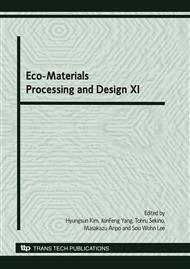p.57
p.61
p.65
p.69
p.73
p.77
p.81
p.85
p.89
Effect of Silicon Carbide Susceptor and Nickel Catalyst Content on Microwave Enhanced Thermal Conversion of Glycerol Waste
Abstract:
Glycerol waste is by-product from the manufacturing of biodiesel by transesterification method containing impurities such as fatty acid, alcohol, spent catalyst, soap and water. Conversion of this waste to value added fuel products would not only improve economic of biodiesel production but also reduce environmental impact from this process. In this work, thermal conversion of glycerol waste by microwave that induced the heat required for initiating the reaction was carried out in a fixed bed quartz reactor using silicon carbide as the bed medium for microwave receptor as well as supporter for nickel catalyst. For non-catalytic reaction at 220W (700°C), carbon and hydrogen conversions were 22.89% and 19.59%, respectively. Gas production was 0.12 L/min syngas, 0.07 L/min H2, 0.82 MJ/m3 of LHV, and 1.27 H2/CO. In catalytic test, the highest syngas, H2, and LHV of 0.41 L/min, 0.23 L/min, and 9.18 MJ/m3, respectively, were obtained from 1%Ni/SiC while the highest H2/CO of 2.72 was obtained from 0.5%Ni/SiC. The 1%Ni/SiC test also resulted in the highest conversion of carbon and hydrogen as much as 79.50% and 83.26%, respectively. For comparison between fresh and regenerated catalysts, it was found that fresh catalyst performed significantly better that regenerated one in term of higher total conversion which may due to sodium deposition on spent catalyst surface.
Info:
Periodical:
Pages:
73-76
Citation:
Online since:
July 2010
Price:
Сopyright:
© 2010 Trans Tech Publications Ltd. All Rights Reserved
Share:
Citation:


